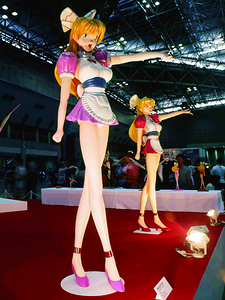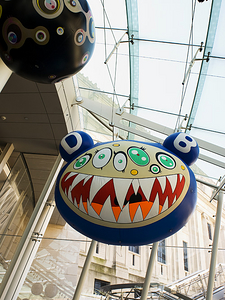
727-727
2006
Acrylic on canvas mounted on board
DOB, the perky character with Mickey Mouse-like ears, is the single most represented subject in Takashi Murakami's works. 727-727 portrays DOB as vicious and grotesque, with sharp teeth and glaring multiple wild eyes -- an antithesis to Walt Disney's affectionate characters. The background patina and cloudlike strokes under DOB evokes Japanese traditional painting techniques.

Flower ball (3D)
2002
Acrylic on canvas mounted on board
The smiling chrysanthemum theme also recurs in much of Mr. Murakami's works, as well as on a wide range of Murakami merchandise: key chains, shirts, even soccer balls. Mr. Murakami was trained in classical Japanese painting and his flower motif is seen as a modern take on more traditional works featuring the chrysanthemum, which is the symbol of Japan's imperial family.

Inochi
2004
FRP, steel, and lacquer
Mr. Murakami's sculpture series, Inochi, is rooted in Japan's obsession with humanoid robots. Part human boy and part cyborg, Inochi -- which means "life" in Japanese also features in a series of video clips by Mr. Murakami.

Installation view of Miss ko2 (Project ko2) at Wonder Festival, Summer 2000
1997
Oil, acrylic, fiberglass, and iron
Miss Ko2 is a sculpture inspired by Japan's "otakus", often defined as young men obsessed with animation, comics, or video games. Many of Mr. Murakami's works blur the boundaries of Japanese pop culture with art.

Tan Tan Bo
2001
Acrylic on canvas mounted on board
In this work, DOB has evolved into a gigantic, toothy monster with liquids oozing from his mouth, a fantastical work set against a flat sky that is characteristic of Mr. Murakami's paintings.







 I wish I could own some of his art *sigh*
I wish I could own some of his art *sigh*